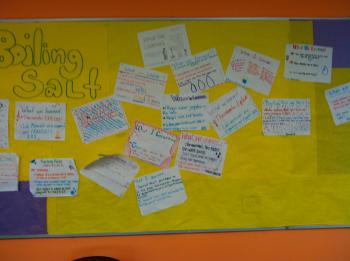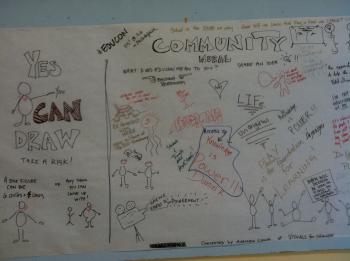Serendip is an independent site partnering with faculty at multiple colleges and universities around the world. Happy exploring!
Field Notes 2/26/13
Field Notes 2/26/2013
Today is the “Book Publishing Party” that Teacher A has been talking about for the past couple weeks. This book publishing party is the culmination of their research project that they have been working on for the entire time that I have been here. Teacher A announces that the book publishing party will be happening at the beginning of class, but before the class gets to celebrate, they have to spend first period doing standardized test prep.
During the test prep period, Teacher A has me work with two students who have worked with before, but separately. While this is a 6th grade class, these students are doing the test prep for the 4rth grade level. Teacher A has written a note for me indicating which sections in the packet the students should have complete and asks me to go over the answers to the multiple choice questions for these sections. Teacher A does not have an answer key for the tests and so she gives me a few minutes to read through the sections, the questions, and attempt to answer the questions. While many of the questions were pretty straight forward, there were a few that I felt like were open to interpretation.
Journal Entry 5
Today I had my first field placement. I am placed in a 6th grade classroom at a college prep school designed for students with learning differences. The thing that jumped out at me the most at my field placement today was that the “how” of literacy education was really coming through in an obvious way in this classroom. It was obvious to me today that many of the students in this class, because they have learning differences, have been grouped in with students who lack the literacy skills necessary to excel in regular education classrooms. This classroom is unique because it consists of predominantly wealthy white upper middle class students who come from homes that value education. They are also being provided with the support they need to acquire the literacy skills necessary to succeed in higher education. Literacy skills were being explicitly taught in a way that would not be seen in regular education classrooms especially at a 6th grade level.
Here is a short list of some of the teaching techniques that I observed today to help the students learn literacy skills. Many of these are things that I myself do automatically and that many kids learn to do over time on their own.

What Transpired (X Series)
He is solid wood
Seasoned with wind and fighting
To light sodden logs
Bright is life and death is steam
Fire alarm am I.
Cross visitation field notes
Questions/ideas Laura and I discuss on the train ride over: What type of high school school is it (charter, public, private, and magnet) and what are the implications of that? Laura has described the school as very progressive; I wonder how/if social justice is included in the curriculum. What is the school community like, including, but not limited to, teacher and student relationships?
Arrive at school about 10 minutes before class begins and so decide to walk around/wander the halls. There are so many cool things on the wall, which range from posters, to students art work, to big pieces of paper with a question and students’ responses. The topics all seem to be progressive/current in some way: one paper with student responses on it was about the recent election and Romney/Obama debate; one poster advertises the multicultural club; students’ artwork includes, but isn’t limited to, themes of gender and feminism. These stood out to me because these seem like difficult subjects for high school students to approach. There was also a sign advertising multicultural club, which had prompting questions (“do you feel like you don’t have a culture?”). Laura points out there is an LGBTQ Ally sticker on most or all of the classroom doors.



Full Hunger Moon
❍
Silent within, dead still about.
Prone and alone,
Awake and without.
The pump pulls water from the ground, a sound,
Three thirty resolutely rolls around.
A fear, unclear; my souvenir,
Springtide strong-arm seclusion, unbound.
Journal 5 Post
My journal group and I had come up with the following that teachers should remember to use in their classrooms,
- Initiate a common ground in learning abilities for students.
- Encourage and support a student’s self-progress.
- Encourage student teaching/peers helping one another with the material.
- Acknowledge students for good behavior.
For the first bullet presented, my group and I had discussed the importance on making students feel comfortable. For instance, one of my peers had mentioned how there was a second grader at her praxis site who had refused to read a term that the rest of his peers couldn’t read either and instead had put his head face down on his desk. It was clear that the student had felt uncomfortable by refusing to read and its possible that he most likely felt frustrated because maybe some of the other students were able to read that term but he couldn’t. In order to prevent students from feeling uncomfortable and frustrated our group thought it would be great if teachers could create an atmosphere where the students know that everyone will be learning and going through the same thing, thus initiating a common ground for everyone.
I'm not saying that this is a definite list that teachers should keep in mind when educating their students, this is just what my journal group and I had come up with and believe that this could help give students a more positive educational experince.
Field Notes 2/26/13
February 26th, 2013
Ms. R 11th Grade American History
Mr. T 10th Grade English
Today was a fun day in my field placement because Sarah came with me for our cross-visit! We talked a lot about some issues I’ve been thinking about and she brought to my mind some things I hadn’t thought of before.
As usual, the students in Ms. R’s American History class were working on their big “benchmark project.” I learned that each quarter there is a benchmark project, with a clear grading rubric. There are multiple parts to this project. Last week the students researched the causes of the Great Depression and studied the New Deal. This week they are researching the causes of the Great Recession. The final project will be a comparison of the responses to the Great Depression and the Great Recession. Ms. R has almost the identical assignment as last week, with 3 sources and guided questions. She only says a few words at the beginning of class and then tells them to start working. Sarah and I are walking around looking at their visual depictions of their projects from last week and they are clearly excited to “show off” their work and explain it to us.

Procedure
Give in.
Go ahead,
Slice my soma.
Violate my
Parotid stroma.
Just please don't let me
Wake up in a coma.
Pleomorphic Adenoma.

Becoming comfortable...
In the beginning of class, the students did their Do Now and studied their vocab words for the quiz. The teacher asked me to pull individuals who struggled to finish his/her homework-- reading and giving meaning to poems in a pre-made packet -- during the quiz time. I knew from the get go, I didn’t want to give the answers to the students right away if they got confused. As a student, I have always benefited from my mentors questioning me in order to help me figure out the answer on my own. The goals of the exercises in the packet were to help the students build their vocab and the ability to interpret stories and poems. Most importantly, the goal was to prepare these ELL students for the benchmark exam.


